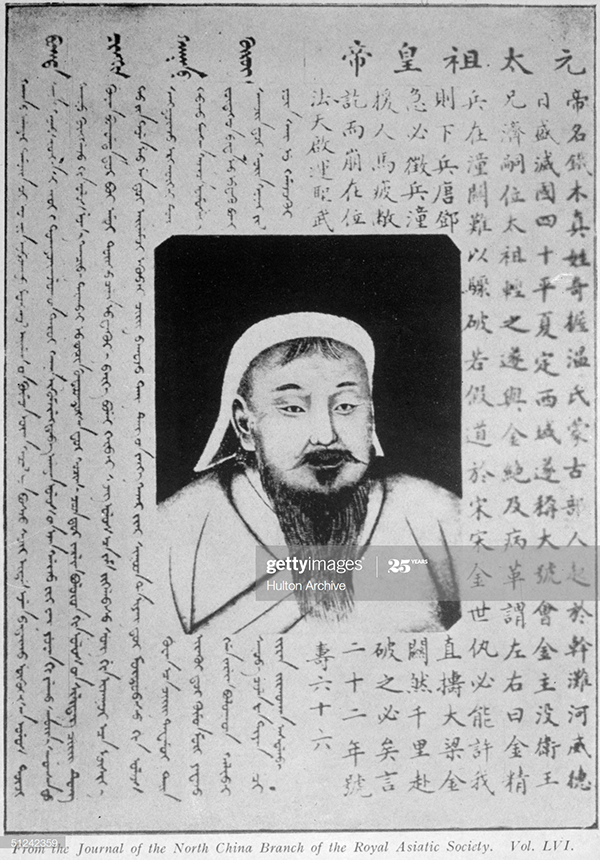
1762年记录成吉思汗生平的两种文字
“成吉思汗是一个恶魔领袖,凡是他征服和占领的土地上的百姓,他都会全部斩杀并肢解尸体。”这是当初我看到介绍之后对成吉思汗最初的印象,相信许多读者可能也听到过同样的话。在这样一种第一印象下,我开始对成吉思汗进行研究,可结果却让我大吃一惊。
1260年正值蒙古帝国鼎盛时期,其版图包括了现今的蒙古、俄罗斯部分地区、乌克兰、土耳其、伊拉克、伊朗、中国北部、印度北部和朝鲜。蒙古帝国是世界历史上的第二大帝国,人口占全球人口19.5%,仅次于殖民地时期的大英帝国。
成吉思汗常常被描绘成一个非常残忍的领袖形象。据历史记载,在帝国版图扩张时期,他东征西讨,所到之处尸横遍野。但是他反对折磨或拷打俘虏,在他们的观念里人的身体是神赐予的,不容亵渎。
认为成吉思汗很野蛮的那些人,往往忽略了蒙古军队是一支纪律严明,拥有当时最先进的技术这一事实。比如,他的军队拥有当时的良弓箭矢、火药大炮,以及在敌方执行间谍任务的卧底。
除了军事技能,这位领导人还提出并实行开放的国家政策。尽管成吉思汗奉行的是“腾格里”信仰,但帝国仍然允许宗教信仰自由。由国家财政出资,在今天的俄罗斯境内的蒙古帝国管辖范围内修建古兰经学校,在今天的中国境内修建基督教教堂。成吉思汗还在军队里建立了按军功晋级的军衔制度。
他推行的其他政策如首个国际邮政系统也收到了很好的治国理政效果。成吉思汗还减免各行业的赋税,废除了医生、牧师和教师的所得税。他把中国的医生派往印度学习草药知识,同时从西亚派医生到中国学习外科手术技术。
书记员和翻译职业受到当时社会的高度重视。有学者认为正是在成吉思汗的统治下“丝绸之路”才形成了一个统一的体系。在那个时代,国家划拨资金给历史学家,鼓励他们记录和撰写被征服地区的历史典籍。任何有技术和受过教育的人,都可以为帝国效力。
成吉思汗鼓励发展地区间贸易,比如,他把中国的茶叶出口给印度的农民。有些学者大胆假设:这些早期的贸易和通讯边界就是形成现代国家边界(如印度和中国边界)的基础。
1227年成吉思汗去世后,他的子孙继续统治蒙古帝国。大汗有四个儿子,大儿子术赤(Jochi),二儿子察合台(Chaghtai),三儿子窝阔台(Ogedai),和小儿子托雷(Tulai)。后来三儿子窝阔台继承了汗位,然后传给了贵由(Guyuk),再后来传给了蒙哥(Mongke)。成吉思汗的子孙们控制了整个帝国,并把它划分为四个区域:俄罗斯、中国、波斯和蒙古。
在成吉思汗家族的统治下,蒙古帝国延续了700年之久。在印度,莫卧儿帝国是继蒙古帝国之后的继承国之一。1526年征服印度次大陆的第一位莫卧儿皇帝巴布尔(Babur),是成吉思汗的二儿子察合台的后裔,来自巴布尔的母亲一族。莫卧儿帝国的统治直到1857年灭亡。在中国,成吉思汗家族的统治一直延续到1368年元朝建立。元朝由忽必烈皇帝开始统治,一直到被明朝更替。而统治着现今乌兹别克斯坦的最后一位蒙古后裔,直到1920年才被灭国,失去权杖。
成吉思汗在历史上的成就,很可能与他儿时经历的争斗有关。成吉思汗出生于1162年,父亲是蒙古乞颜部首领也速该(Yesugai),母亲诃额仑(Hoelun)夫人,都来自中亚游牧部落。成吉思汗小时候,父亲被人谋害毒死,他和家人被赶出家族,只能靠打猎为生。后来,他在军队中屡立战功,逐渐成长起来,壮大自己的势力,最后改变了整个世界格局。他死后,史官编写的《蒙古秘史》一书记录了他的生平事迹。
有一点我们不要忘了,因为蒙古帝国的历史久远,所以要完整记录成吉思汗所有的历史事件往往很困难。虽然这段历史充斥着暴力和战争,但就像所有帝国的历史一样,它也给世界带来了很多积极的变化。我们今天的世界格局和面貌,当今的文化,很大程度上都受到成吉思汗思想的影响。
" />
Written by: Ushna Khan
Posted on: April 17, 2020 |  | 中文
| 中文
Wax Figures of Genghis Khan & His wife B
“Genghis Khan was a ruthless leader who killed the people he conquered, and mutilated the bodies.” This is my earliest introduction to Genghis Khan, and many other readers might also know of the ruler in terms of his unparalleled cruelty. Under this impression, I started research and was left surprised by how vastly historical evidence differs from the legends and hearsays.
Genghis Khan came from Mongolia, a country in the South of Russia and North of China, and is two times smaller than the territory of India. At the height of the empire in 1260, it included: Mongolia, Russia till Moscow, Ukraine, Turkey, Iraq, Iran, Northern China, Northern India and Korea. Mongols had the second largest empire ever in world history, which dominated 19.5% of the earth. It was only second in comparison to the colonial British empire. To quote Jack Weatherford, “Genghis Khan conquered twice as much territory as any other man in history.”
Often, Genghis Khan is depicted as a cruel leader, whose soldiers mutilated the bodies of dead. As he expanded the empire, there were mass killings recorded, but the word “cruel” is often overused. Mongols were against the concept of torturing the human body, as they held it to be sacred.
The idea that he was a barbarian, often overlooks the sophistication of the Mongol army, who were highly disciplined and employed the most advanced technological machinery of their time. Some examples include the use of composite bows, as compared to European simple bows; cannons using Chinese gunpowder, Muslim flamethrowers and European bell-casting, and reconnaissance missions before attacking enemy territory.
Next to his military prowess, the leader also introduced progressive policies, that have been cited by historians as foundations of the modern world. Even though Genghis Khan practiced the ancient, shamanic religion of Tengrism, the empire followed a policy of religious freedom. His empire financed construction of Quranic Schools in Russia and Christian churches in China. Khan broke class systems in the conquered areas, and focused on building ranks based on merit and individual achievements.
Other progressive policies include the first international postal system throughout his empire. He lowered taxes, and abolished them altogether for doctors, priests, teacher and educational organizations. Mongols sent doctors from China to India to learn about herbal cures, and sent doctors from West Asia to China to learn surgery.
Scribes and linguists were held in high regard, as they were needed to communicate orders across the vast empire. Some even say that his rule helped the Silk Route come under one coherent, political system. State-sponsored historians were funded to write histories of the conquered regions. In fact, anyone who was skilled and learned was both valued and employed in some part of the empire.
Trade between conquered regions was encouraged, such as the export of Chinese tea to farmers in India. Some hypothesize that these early trade and communication boundaries established territorial lines, which have become the boundaries of modern nations, such as India and China. But how was this brought about?
After Genghis Khan’s death in 1227AD, his children succeeded him. He had four sons, Jochi, Chaghtai, Ogedai and Tulai, and Ogedai became the next Khan. Later, the title went to Guyuk and then to Mongke Khan. Following this, his grandsons controlled the empire, dividing it into four regions: Russia, China, Persia and Mongolia.
The Mongol rule lasted 700 years under the control of Genghis Khan's family. In India, The Mughals were one of the last successor states of the Mongols. The first Mughal Emperor Babur, who conquered the Subcontinent in 1526, was a descendant of Genghis Khan’s son Chaghtai, from Babur’s maternal side. The empire lasted till 1857, ending with the exile of Bahadur Shah Zafar. In China, they ruled till 1368 under the Yuan dynasty, which was started by Kublai Khan, until it was defeated by the Ming Dynasty. Records of his life can be found in “The Secret History of the Mongols”, the oldest surviving account of Mongol life, written a little after Genghis Khan’s death.
Genghis Khan’s achievements are truly fascinating in retrospect, and it is likely that the struggles he faced as a child helped mold him the leader he became. Born in 1162 to Yesugai and Hoelun, Genghis Khan or Temujin was a descendent of nomadic tribes from Central Asia. His father was poisoned when Genghis Khan was a young boy; following his father’s death, Genghis Khan’s family had to rely on hunting to survive. He slowly rose through military ranks, and left his mark on the world for centuries to come. Records of his life can be found in “The Secret History of the Mongols”, the oldest surviving account of Mongol life, written a little after Genghis Khan’s death in 1227.
What must be remembered, is that Genghis Khan’s history is often narrated like a game of Chinese Whispers, in which the final account differs vastly from the original statement. While there was violence and war, as there is in all conquests, there was also a great deal of innovation in all fields. Our world and culture as it is today, is indebted to Genghis Khan’s vision and progressive thinking, despite the misconceptions of his legacy and contributions.
You may also like: